Managing Mid to Late Season Diseases in Cotton
August 23, 2024
KEY POINTS
- Minimizing cotton stress early in the season can help reduce disease severity and maintain cotton yield potential.
- Cotton should be scouted regularly for accurate identification of foliar, wilt, root, and boll diseases from the fruiting growth stage through defoliation.
- Improper nutrient management can increase the frequency of some cotton diseases.
- Some diseases have a symbiotic relationship with parasitic nematodes.
- Southern root-knot, reniform, lesion, Columbia lance, and sting nematodes can cause “weak spots” in a field that can be confused with cotton diseases or nutrient deficiencies.
- Since many mid- to late-season production problems do not have an in-season control option, the only control measures available may be cultural or chemical options to reduce the occurrence of these diseases in the following cotton crop.
Introduction
Several factors complicate the management of mid- to late-season cotton diseases. Early and mid-season stress—such as drought, flooding, insects, nematodes, and poor fertility, among others—may increase the occurrence of cotton diseases later in the season. Therefore, it is important to continually scout the cotton crop throughout the growing season, as timely disease identification is critical to determining the correct control measures, treatment, and timing to help protect the crop’s maximum yield potential.
Click on the disease to learn more
Foliar disease pressure increases when a cotton crop is under stress. Mitigating stress, as much as management allows, can help reduce disease pressure and protect the yield potential of the crop. Managing irrigation, fertility, insect pressure, and growth can reduce the potential occurrence of foliar disease. Rank growth should be controlled with a plant growth regulator (PGR) application along with managing water and fertility. Crop residue that is infected with diseases should be chopped and incorporated into the soil to accelerate decomposition, which can help reduce the occurrence of foliar diseases in the following cotton crop.
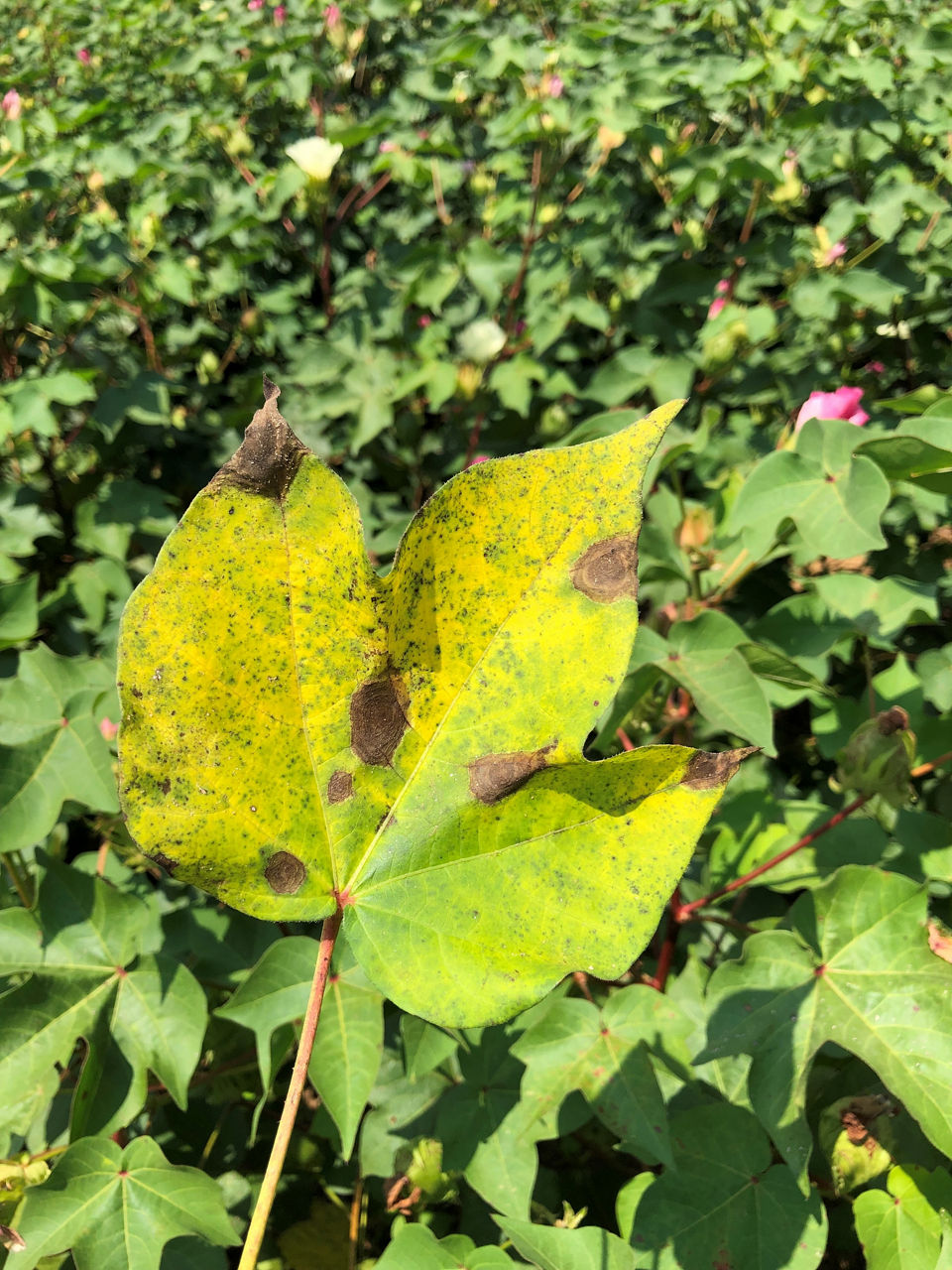
Target Spot (Corynespora cassiicola)
Symptoms
Target spot (Figure 1) typically starts in the lower or inner canopy with small, reddish-brown spots, one inch in diameter, with light and dark concentric rings. There is no dark band bordering the spots.1 This disease usually occurs after extended periods of leaf wetness. Defoliation starts at the bottom of the plant and progresses upward.
Diagnostic Notes and Control
Control rank growth with PGRs and water management. Fungicides are available and, if needed, an application should be applied during both the first and third weeks of bloom.
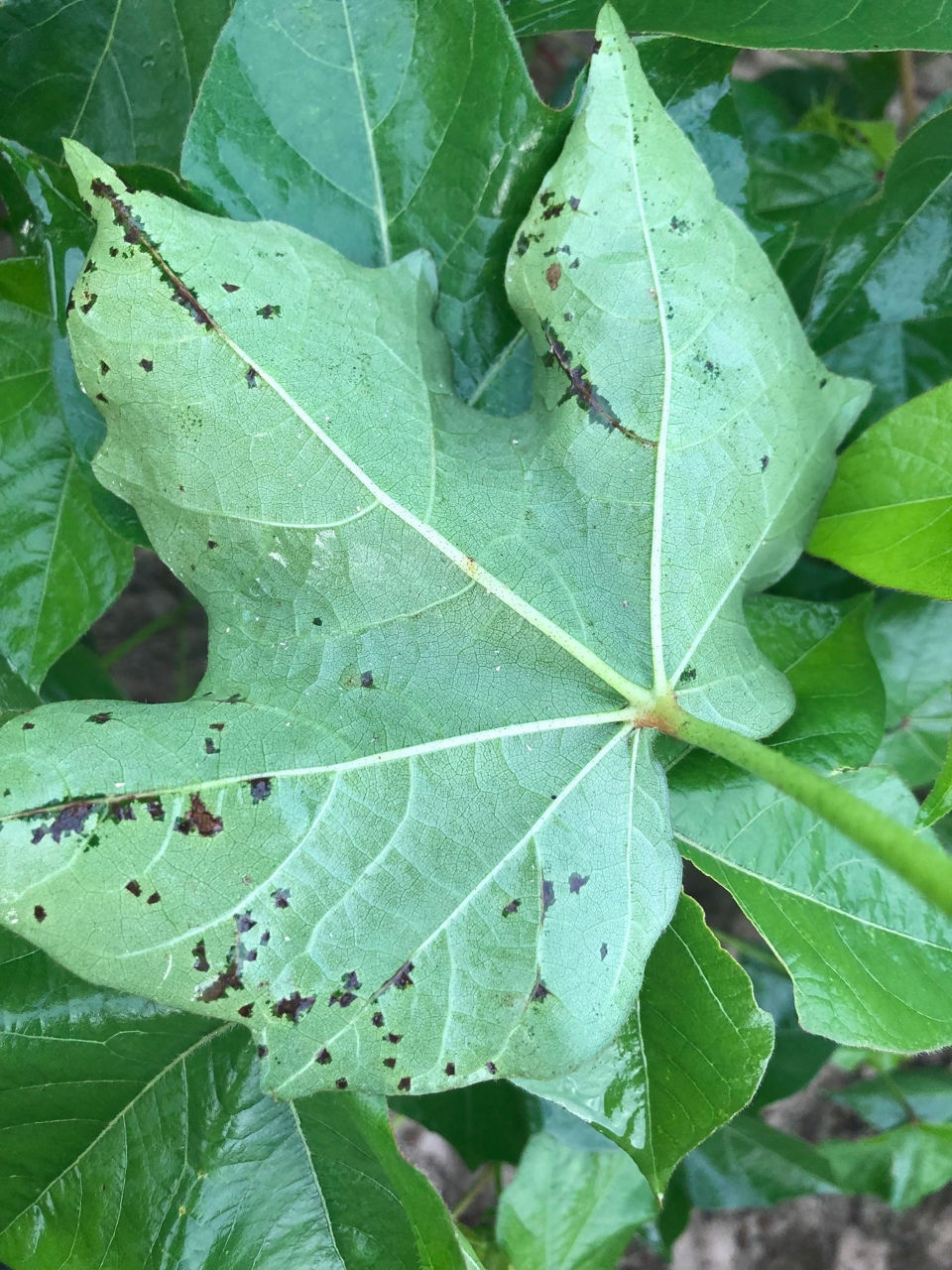
Bacterial Blight (Xanthomonas campestris pv. malvacearum)
Symptoms
Bacterial blight (Figure 2) can be identified by the small, light green, angular, water-soaked lesions it produces on leaves. Blight-infected bolls will have round, sunken, water-soaked brown lesions. Lesions appear on the upper side of the leaf and turn black as they get larger, and defoliation may occur.1
Diagnostic Notes and Control
Resistant cotton varieties are available for most growing regions. Reduce rank growth and consider crop rotation, along with residue management that incorporates residue into the soil to decompose the infected debris to reduce disease pressure on the following cotton crop.
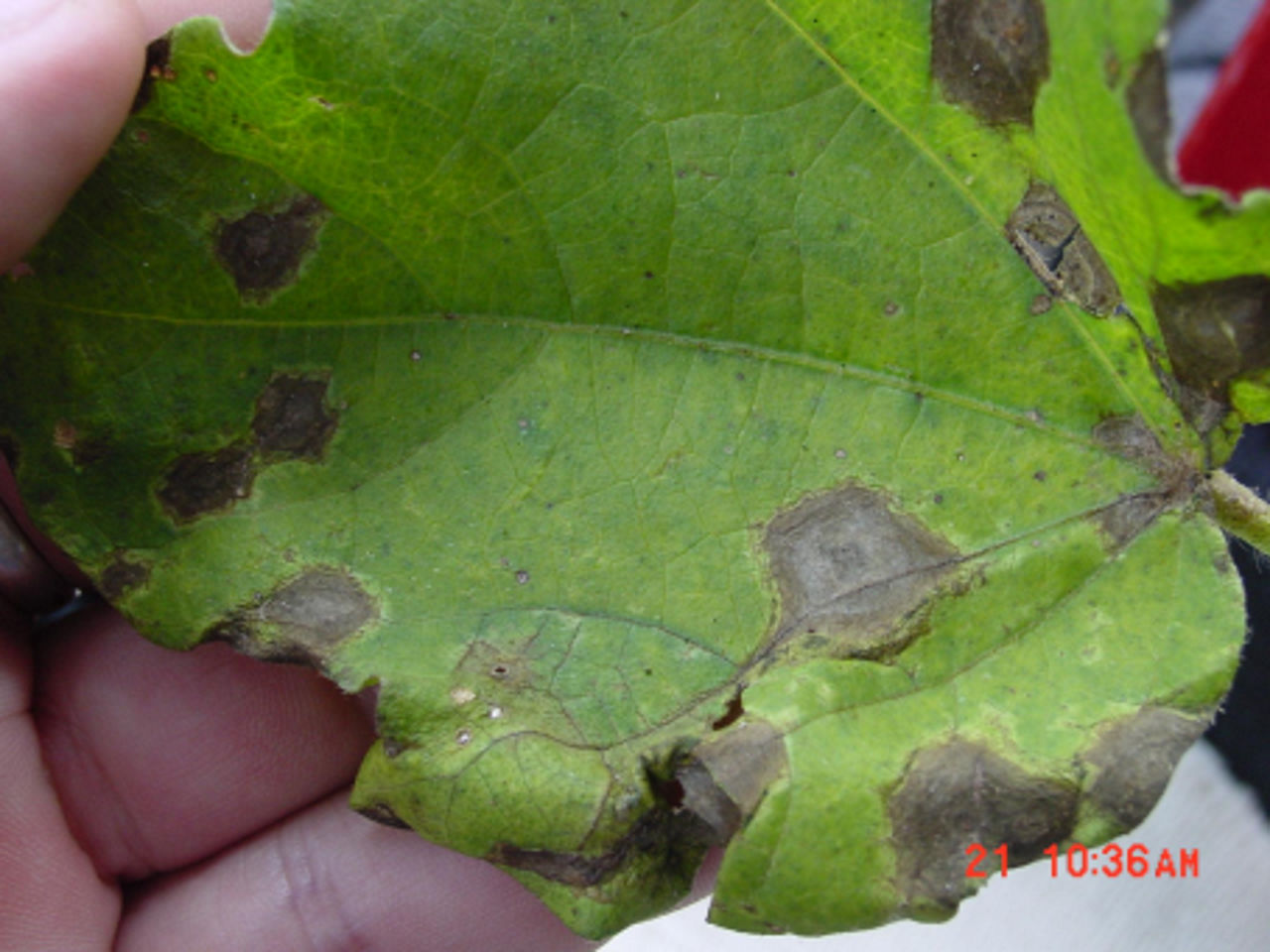
Alternaria Leaf Spot (Alternaria macrospora) and Stemphylium Leaf Spot (Stemphylium solani)
Symptoms
Alternaria leaf spot (Figure 3) and Stemphylium leaf spot both produce small, brown, circular lesions with purple margins on leaves that grow to 0.4 inch in size. Old lesions have gray centers with necrotic tissue falling out, giving the leaf a “shot hole” appearance.1 Small purple spots may also develop.
Diagnostic Notes and Control
Alternaria leaf spot is more common in Texas and the Midsouth. Stemphylium leaf spot is more common in the Southeast. Reducing plant stress and ensuring proper soil fertility, especially with potassium, can reduce disease severity. Fungicides are available to manage these diseases.
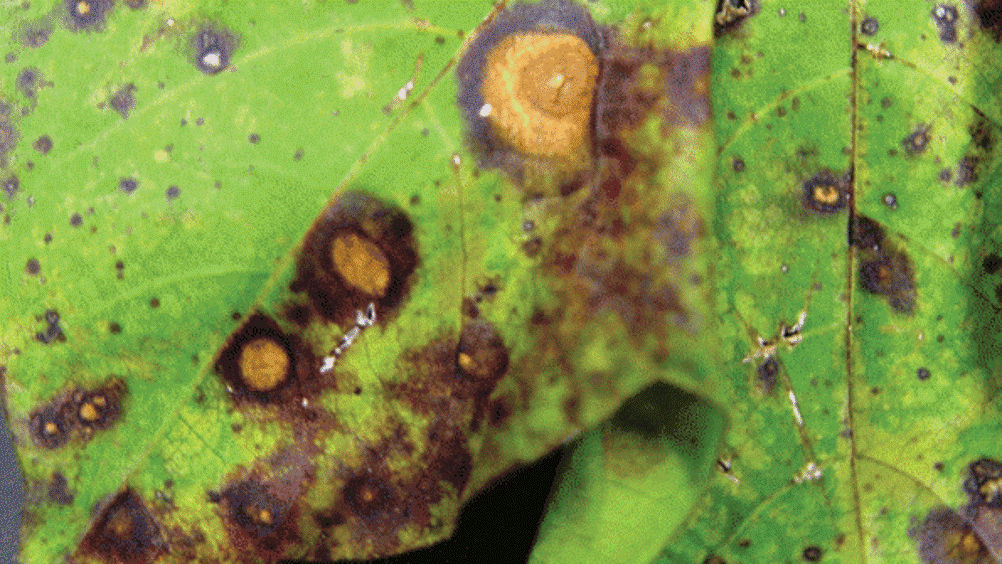
Cercospora Leaf Spot (Cercospora gossypina)
Symptoms
Cercospora leaf spot (Figure 4) causes small reddish-purple foliar lesions that turn white as they enlarge, developing a light center surrounded by narrow purple to red margins.1 Old lesions may be 0.7 inches in diameter. Lower yield and fiber quality can occur when the infection occurs with another disease or diseases.
Diagnostic Notes and Control
It is often difficult to differentiate Cercospora leaf spot from other foliar diseases, and Cercospora often occurs with Alternaria or Stemphylim leaf spot. Plants with moisture and nutrient stress are more susceptible to this disease. Fungicides are not considered effective against it.
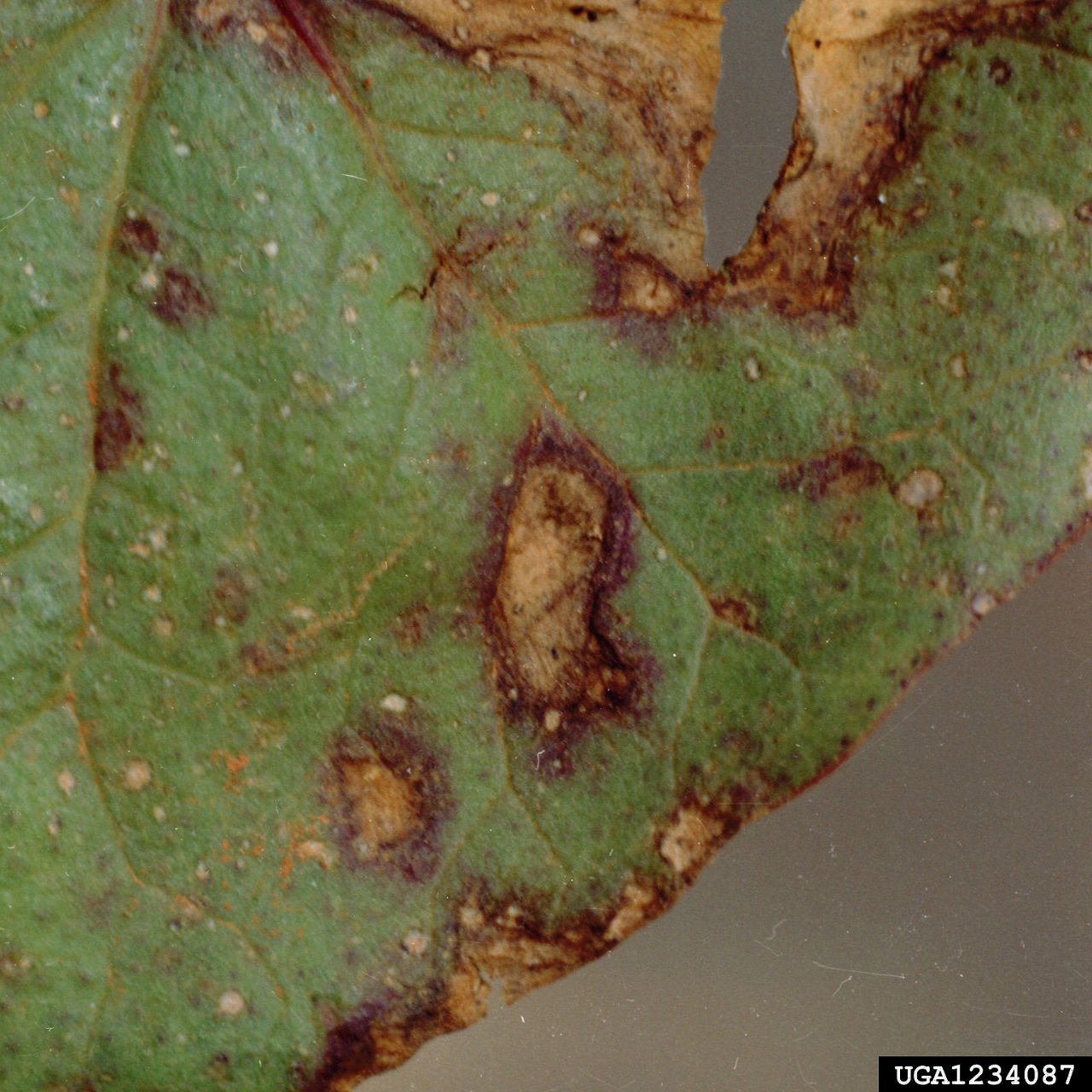
Ascochyta Blight (Ascochyta gossypii)
Symptoms
Ascochyta blight, also known as wet weather blight (Figure 5), forms lesions on cotyledons, leaves, stems, and bolls. Lesions on the cotyledons and leaves start out small, less than 0.1 inch in diameter, and are white to light brown in color.1 Lesion centers may crack and fall out. Lesions on the stem enlarge into irregular-shaped cankers that are reddish-purple to black or ash gray, with a dark brown border.
Diagnostic Notes and Control
Control can start with fungicide-treated seed. Infection can occur early in the season and is usually associated with cool, wet conditions. Fungicide options are available, but generally not warranted, as yield loss is rarely reported with this disease.
Conclusion
Each mid- to late-season disease has very different control measures. There are often similarities between the symptoms of the diseases, so proper identification is critical. Help with accurate disease identification can often be found by contacting your local agronomist, extension cotton expert, or your local seed expert. In some cases, a sample will need to be sent to a local cotton disease diagnostic laboratory for accurate identification. While some diseases have an in-season control option, many do not. To complicate control measures, many diseases have a synergistic relationship with stress issues like a fertility, nematodes, weeds, or even irrigation timing. This is why the correct identification of the pathogen is critical, as is understanding that the use of cultural control for the current growing season or the following cotton crop may be the only control options available. Some of the cultural control measures used for cotton disease control include:
- Variety selection (tolerant varieties).
- Crop rotation.
- Nematode control.
- Proper fertility (especially nitrogen and potassium).
- Starting and keeping the crop weed free by controlling common weeds and volunteer cotton.
- Wider row spacing.
- Residue management by incorporating infested cotton residue.
- Irrigation management.
- Optimal planting date and crop maturity.
Sources
1Wade, B., Kemeraiy, B., Brock, J. et al. Diagnosis and management of foliar diseases in the United States. Cotton Incorporated.
https://www.cottoninc.com/wp-content/uploads/2018/01/Diagnosis-Management-Foliar-Diseases
2Kemerait, B. and Virk, S. 2021 Late-season disease and nematode management considerations for cotton growers. University of Georgia Extension. https://georgiacottoncommission.org/late-season-disease-and-nematode-management-considerations-for-cotton-growers/
3Wheeler, T. 2022. Update for cotton diseases in 2021, including the latest on management for nematodes, Fusarium wilt, bacterial blight, and Verticillium wilt. Texas A&M AgriLife Research. https://www.planthealthexchange.org/cotton/Pages/GROW-COT-01-22-319.aspx
4Liu, J. and Wagner, T.A. 2022. Detecting and genotyping of Fov4 (Race 4, VCG0114), the Fusarium wilt pathogen of cotton. Methods in Molecular Biology. 2391: 191–205. https://pubmed.ncbi.nlm.nih.gov/34686987/
5Cotton. In, Texas Plant Disease Handbook. Texas A&M AgriLife Extension. https://plantdiseasehandbook.tamu.edu/industry-specialty/fiber-oil-specialty/cotton/
Web sites verified 07/25/2024. 1411_130049